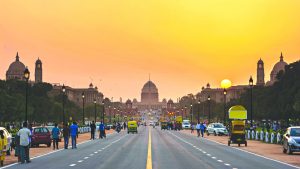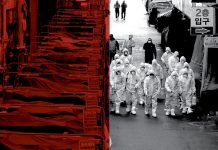 The global economic order is in an amorphous state with the outbreak of the Covid-19. However, this amorphousness is nothing new. Ever since China announced its Belt and Road Initiative (BRI) around seven years ago, the debate on an emerging new global economic order had been floating.
The global economic order is in an amorphous state with the outbreak of the Covid-19. However, this amorphousness is nothing new. Ever since China announced its Belt and Road Initiative (BRI) around seven years ago, the debate on an emerging new global economic order had been floating.
With BRI being a global development strategy involving infrastructure development and investments in nearly 70 countries to exploit the cheap factor markets and the expanding product markets, it can well be construed as a “market imperialistic” design that has rocked the status quo of the global political-economic order. At almost the same time, the last 3 to 4 years witnessed insulating tendencies of some of the major economies that were advocates of free trade philosophies.
This coincided with the emergence of strong (wo)man leaders, and consequent dominance of the nationalistic fervours originating from a xenophobic discernment of some global powers. The BRI and the very existence of China in any trade bloc was definitely a catalyst to this tendency of economies getting into shells. Evidence of such insulating tendencies include US’s withdrawal from the TPP, prolonged US-China trade war, Trumpian disregard of the Climate Change crisis and Brexit.
On the other hand, China’s BRI began obtaining momentum with nations from the EU, Asia and Latin America joining in. This marked the happy ride of China on its BRI horse, which was attempted to be combated by coalitions like the “Quad” in the Indo-Pacific — a potential security arrangement among the four large democracies, Australia, India, Japan, and the US. It is at this juncture that the globe got affected by Covid-19. In the globalised world, the spread of the virus did not take time with more than 210 nations being affected in varying degrees. The most interesting observation is that the economies with highest levels of exposure to China, either through BRI or otherwise, are the ones most affected by the Coronavirus.
This exposure can largely be delineated by three variables, namely, trade, investment, and human capital movement. This can be evinced with the case of Italy, one of the highest Covid-affected nations. China was not only Italy’s largest cooperative trade partner, but ever since the nation became a BRI member in 2019, it emerged as one of the major destinations of Chinese FDI. Iran’s exposure to China was in the form of the latter being its biggest trading partner with massive Chinese investments and labour being flown to Iran.
Similarly, high export exposure of South Korea to China often occurs through assembly lines before being re-exported to other nations. While definitely the infection is caused by physical proximity of citizens of affected countries, at a more macro-scale there is substantial evidence about the role of trade, investment, and human capital movement in transmitting the virus. It is quite obvious that economies will be taking counteractive measures through closure of borders.
This is bound to bring about a significant change on the plans for regional connectivity. With economies getting insulated as an immediate response to the crisis, globalization goals will be severely affected. Trade routes will be seen with suspicion, and investment in foreign destinations to exploit the global value chains (GVCs) in usual destinations will be cast with doubts.
While the economies are getting more insulated with closure of borders and international migration, the virus has created suspicion among nations, as can be evidenced with US President using the term “Chinese virus”, China blaming US for the spread, Germany asking for reparations from China, Tanzania denying Chinese aids, and India becoming more vigilant with inward FDI flows. The role of the WHO is already under suspicion. From the perspective of trade, WTO’s relevance will be questioned further.
Services sector vital
However, it may be expected that newer forms of institutions will emerge over time to combat this crisis phase, and the growth drivers will change. Already as far as the service sector is concerned, a large part of it has been moving to the digital world thereby creating virtual workspaces replacing the physical workstations. Moreover, the world is already witnessing a heavy reliance on digital connectivity, way away from goals of physical connectivity. However, a large part of the services sector in the developing world remains unorganized and does not feature in the digital space — neither will it be easy to place them there as almost all of it requires physical presence.
This inability of being accommodated in digital space will lead to more poverty, more hunger, and more inequalities thereby hampering achievements of Sustainable Development Goals. This is purely the challenges to the equity dimension of holistic development that is being posed by the pandemic severely affecting good health and well-being. On the other hand, reduced economic activity in the physical space of the planet will definitely be good for the natural environment.
However, sustainable development is not devoid of humans; it talks of the coexistence of biodiversity conservation and development of the human society by meeting with the various equity needs. It is here that one of the most crucial goals gets affected; these are peace, justice and strong institutions. Large parts of the developing and underdeveloped world view this pandemic as one imported by the privileged class through their international travels and free mixing in the occasional ways of life.
Make in India
The Indian government promoted “competitive federalism” among the Indian states through its “Make in India” initiative, with the apparent objective to improve the nation’s rank in the World Bank’s Ease of Doing Business (EoDB) ranking. Research suggested that the states should concentrate on the UN SDGs as major enablers of business competitiveness. This is because Sustainable Development Goals address the input and product market conditions through bolstering the potentially available capital classified in four types, namely, physical capital, natural capital, social capital and human capital, which are critical inputs to businesses to thrive.
Almost all the sustainable development goals are embedded in one form of capital or the other, that is humans (reflecting on poverty, hunger, health, education, and gender equality), physical (employment, growth, industry, innovation and infrastructure), natural (life below water and land respectively) and social (social institutional variables, etc). The econometric analysis showed that the sustainable development index is a statistically significant causal variable explaining the Ease-of-Doing-Business Index, as developed by the Asian Competitiveness Institute (ACI). There is a significant causal relation between this index and per capita Foreign Direct Investment (FDI) in the Indian states, indicating that financial capital gets drawn towards those destinations where enabling business conditions are already created through prevalence of the four types of capital. The Indian imperatives
Will India be a loser or a winner under this changing dynamics of the global economic system? The short-run impacts are going to be negative as expected. It needs to be noted here that it is not only with movement of goods and investment that the gates may be closed, but a more severe impact may be witnessed on labour movements.
The biggest challenge for India will be to place the major component of the services sector that remains unorganized, informal, and has limited reach in the digital space. From a global perspective, China cannot remain a trusted partner anymore. This creates huge opportunities for India. A changing global economic order can make much focus on India as a preferred destination for investment. From that perspective, the eastern states of India will be critical. They present themselves with all four factors of business in abundance, namely, human capital, social capital, natural capital and an improving physical capital. This part is relatively less explored, and can be the fulcrum of development of the region in the Post -Covid world.
Holistic growth
The International Monetary Fund, has been stressing on uninterrupted trade mechanisms. The Indian imperatives should lie on promoting its land as a preferred destination for investments. This can happen if it concentrates on creating a land with minimum transaction costs for business and trade, and for accessing human, natural, social and physical capital smoothly.
The futility of the World Bank-DPIIT metric of Ease of Doing Business has already been exposed by Asian Competitiveness Institute. Therefore, the post-Covid19 India should embrace the important cornerstones of “competitive federalism” for simultaneously meeting two goals: the first is from the perspective of attracting businesses and financial capital; and the second is from the perspective of looking at development through a holistic lens bringing in the efficiency, equity, and sustainability concerns in one frame.
The writer is Director, Observer Research Foundation, Kolkata. The content is from “Covid-19: Challenges for Indian Economy” by EEPC India & Asean India Centre at RIS. Views expressed are author’s own
letters@tehelka.com












